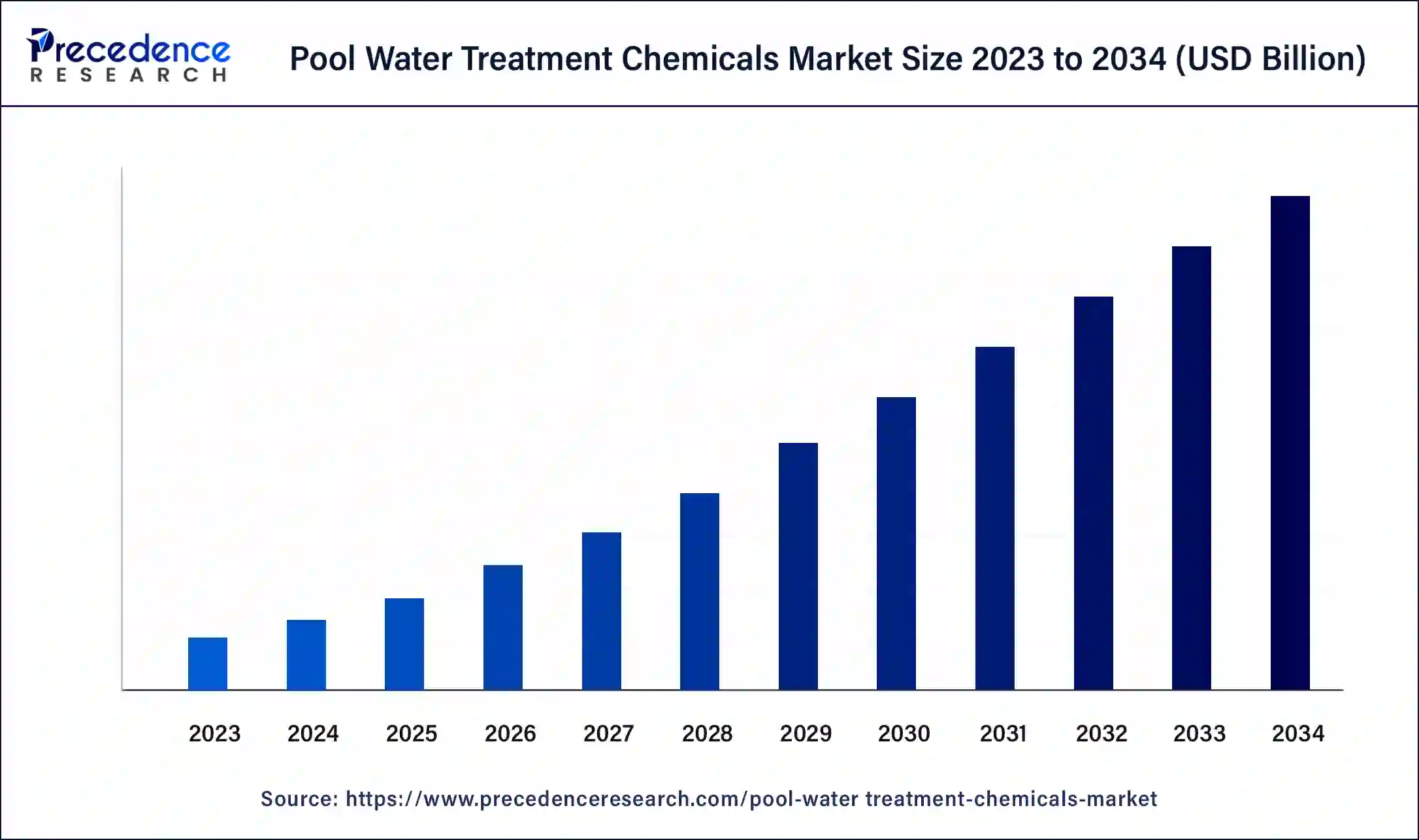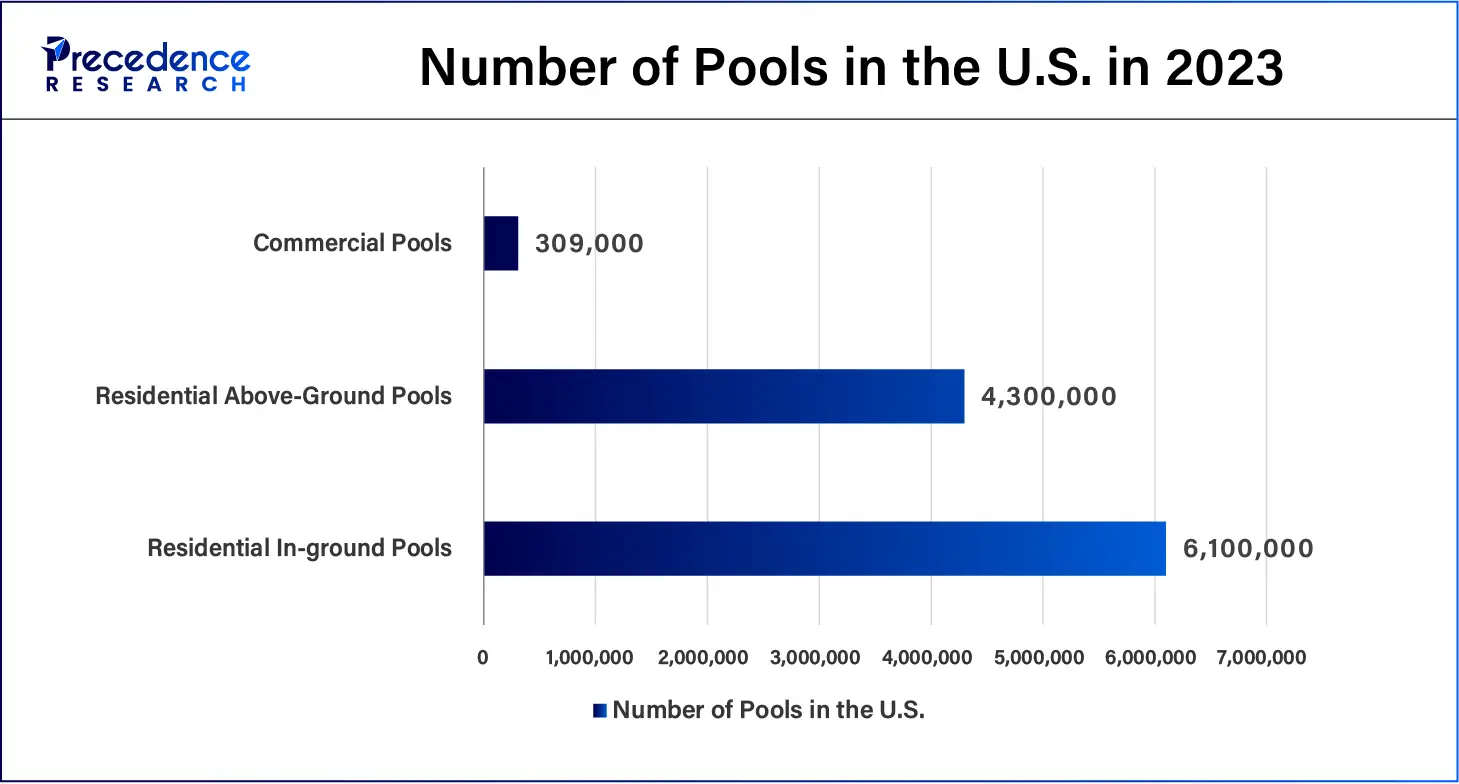January 2025
Pool Water Treatment Chemicals Market (By Type: Bleaching Powder, Sodium Hypochlorite, Liquid Chlorine, Trichloroisocyanuric Acid, Others; By Aplication: Residential Pool, Commercial Pool) - Global Industry Analysis, Size, Share, Growth, Trends, Regional Outlook, and Forecast 2024-2034
The pool water treatment chemicals market is expanding due to increased health and safety awareness and the market is growing at a remarkable CAGR during the forecast period from 2024 to 2034. More construction of pools, better health awareness, new smart technologies, and rising tourism of luxury pools, are acting as the main drivers of demand for the pool water treatment chemicals market.

Swimming pool treatment chemicals are used for pool water disinfection, algal control, and water clarity thus offering clean water which increases the pool's longevity and operational capacity. Keep swimming pools clean and safe for swimmers by reducing germs and microorganisms such as E.coli, Salmonella, and Legionella.
Some of these products are sanitizers, algaecides, pH balancers, water clarifiers, and shock. Pool chemicals are an important tool to protect the health of swimmers. Chlorine and bromine are two antimicrobials that are effective in eliminating bacteria that cause recreational water illnesses.
Lists all of the pool chemicals
| Sanitizers |
|
| Oxidizers |
|
| Water balancers |
|
| Specialty chemicals |
|
AI Impact on the pool water treatment chemicals market
Artificial intelligence has advanced in the pool cleaner industry. AI in pool cleaning is bringing an increase in the efficiency of the cleaning process and improvement of the cleaning performance. The AI algorithms are capable of recording and analyzing the condition of the water such as the pH level, the amount of chlorine and clarity level. Smart technologies for control and monitoring of pool water, through sensors and automations enhances protection and simplifies the maintenance of water chemical balance. It helps provide a safety measure in management of water quality making enjoyable swimming experience for pool users.
| Report Coverage | Details |
| Largest Market | North America |
| Base Year | 2023 |
| Forecast Period | 2024 to 2034 |
| Segments Covered | and Regions |
| Regions Covered | North America, Europe, Asia-Pacific, Latin America and Middle East & Africa |
Health and safety concern
The pool water treatment chemicals market is growing due to increased health and safety awareness. These chemicals are used to maintain clean pool water by eliminating particulate matter such as skin-screening chemicals, personal-care items, bacteria, viruses, protozoa, and anthropogenic particles like skin or hair cells. There is a higher demand for effective treatment chemicals like chlorine, bromine, and UV disinfection systems. Other pool chemicals help with the disinfection process and pH control. Additionally, pool chemicals can improve water quality, prevent corrosion and scaling of equipment, and protect against algal growth.
Side effects of chemicals
The chlorine is used to remove the germ, bacteria, algae, and fungi in the water, chloramines are formed which have effects on the health of the swimmers, and the effects include skin and eye irritation. Persons with respiratory problems like coughing, and wheezing, and asthmatic people cause their condition to worsen.
Urbanization and growing luxury hotels
The global pool water treatment chemicals market has been driven by the increased construction of luxurious hotels, villas, and resorts, as well as increased urbanization rates in growing economies. With an increase in the number of facilities, there is a need for better cleaning and disinfecting pools. Also, urban development increases the development rate of more residential and business facilities. Increasing the awareness of maintaining health and safety standards, and advanced systems for effective maintenance of pools.
The liquid chlorine segment contributed the biggest share of the pool water treatment chemicals market in 2023. Chlorine is the most widely used chemical for the treatment of swimming pool water chemistry because it is very efficient and relatively low cost. Chlorine is the most recognized sanitizer that prevents the development of algae as well as bacteria. It is available in liquid, powdered, and solid forms which are in the form of tablets. Chlorine is a gas utilized in the manufacture of disinfectants such as bleach and other swimming pool products such as sodium hypochlorite. However, it is mostly featured for use with industrial swimming pools where the amount needed is fairly large.
The bleaching powder segment is predicted to grow significantly in the pool water treatment chemicals market over the forecast period. The chlorine present in bleaching powder dissolves in water to form hypochlorous acid and hypochlorite ion which destroy microorganisms and bacteria that are present in the swimming pool facilitating its cleanness. It is widely used for water treatment. The chlorine released by the bleaching powder kills pathogens. Such chlorine remains active in water and ensures that the water does not get infected with pathogens.
The residential pool segment dominated the global pool water treatment chemicals market in 2023. Residential swimming pool means any swimming pool located on private property under the control of the homeowner Residential swimming pools represent a significant market segment attributed to the growing popularity of private pool ownership. The desire for a convenient and safe swimming experience fuels the use of swimming pool chemicals in the residential sector. The rise in the rate of residential construction and the larger number of swimming pools is expected to create growth for the pool water treatment chemicals market.
The commercial pool segment is anticipated to grow at a solid CAGR in the pool water treatment chemicals market during the forecast period. The commercial uses include hotels, resorts, swimming pools for the public, and water parks. High standards of water quality of commercial swimming pools and the growing hotels and resort businesses in various countries are also fueling demand for swimming pool chemicals in the commercial segment. There are several chemicals to be used in the treatment of water, such as disinfectants, pH control chemicals, and stabilizers commonly used in commercial swimming pools. Pools are treated with Chlorine gas, Sodium Hypochlorite (liquid bleach), Calcium Hypochlorite (granules or tablets), Lithium Hypochlorite, or Chlorinated Isocyanurates.
North America dominated the pool water treatment chemicals market with the largest market share in 2023. Due to the heavy density of residential and commercial swimming pools across the region, particularly in the United States and Canada. Substantial pool ownership and maintenance coupled with water quality issues continue to spur demand for pool treatment chemicals. The increasing emphasis on such technologies, as well as on the environmentally friendly products in the region, also helps in the growth of the market.
According to the Pool & Hot Tub Alliance, the United States claims 10.7 million swimming pools, with a breath-taking 10.4 million residential and 309,000 public pools.

Asia Pacific is anticipated to grow at the fastest rate in the pool water treatment chemicals market during the forecast period. A large number of developing countries including China, Japan, India, and South Korea market have a rapidly growing consumer base that can afford luxury goods because of a continually increasing income. More construction of pools across the world is attributed to the growth of urbanization, investment in infrastructure, and an increased usage of treatment chemicals.
Segments Covered in this Report
By Type
By Aplication
By Geography
For inquiries regarding discounts, bulk purchases, or customization requests, please contact us at sales@precedenceresearch.com
No cookie-cutter, only authentic analysis – take the 1st step to become a Precedence Research client
January 2025
February 2025
October 2024
October 2024